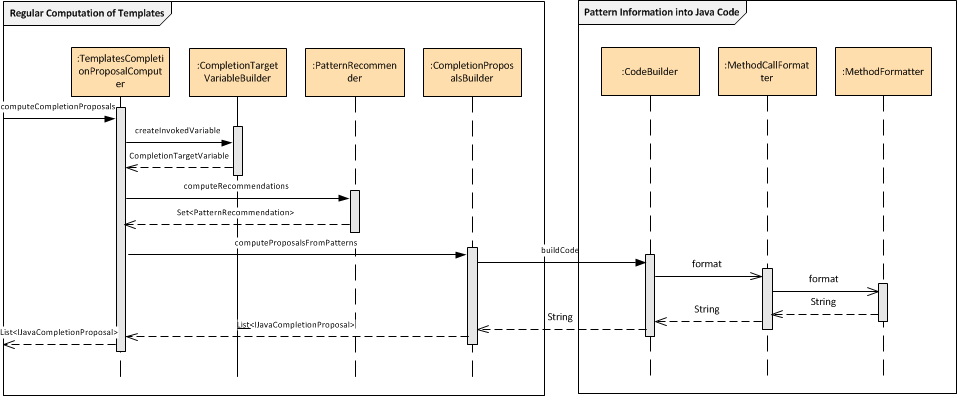Notice: this Wiki will be going read only early in 2024 and edits will no longer be possible. Please see: https://gitlab.eclipse.org/eclipsefdn/helpdesk/-/wikis/Wiki-shutdown-plan for the plan.
Recommenders/Attic/Templates
Contents
Introduction to Templates Completion
The Code Recommenders Template Completion plug-in aims to provide automatically generated Eclipse templates, extracted from a database of mined API usage patterns and fitted to the context of the completion request. This page contains in-detail information about the templates completion plug-in and how it can be used, maintained and extended by developers.
For the rest of this introduction we will present a short scenario which helps the developer to understand the major tasks of the plug-in and possible obstacles in generating templates. In the following we will present the general #Architecture of the plug-in by giving an overview of its components in #Components Overview and how they interact in #General Workflow. We will further explain the most #Important Concepts which further helps understanding the system and are vital to know for working on the plug-in.
Functionality
Eclipse has a built-in templates engine which allows the user to define frequently used code snippets and to insert them with just a few clicks. For a better adaption several variables can be included in order to make templates more dynamic and corresponding to the context in where they are inserted. An overview is given by the Eclipse help pages. However, as the following example for creating an SWT button object illustrates, designing templates can be difficult and time-consuming.
- Default Eclipse SWT template for a new button
${buttonType:newType(org.eclipse.swt.widgets.Button)} ${button:newName(org.eclipse.swt.widgets.Button)}= new ${buttonType}(${parent:var(org.eclipse.swt.widgets.Composite)}, ${style:link(SWT.PUSH, SWT.TOGGLE, SWT.RADIO, SWT.CHECK, SWT.FLAT)}); ${button}.setLayoutData(new ${type:newType(org.eclipse.swt.layout.GridData)}(SWT.${horizontal:link(BEGINNING, CENTER, END, FILL)}, SWT.${vertical:link(CENTER, TOP, BOTTOM, FILL)}, ${hex:link(false, true)}, ${vex:link(false, true)})); ${button}.setText(${word_selection}${}); ${imp:import(org.eclipse.swt.SWT)}${cursor}
Therefore the Eclipse Recommenders Templates plug-in aims to automatically create such templates for (a) providing useful shortcuts to frequently written code and (b) to populate common practices which help new users to learn how frameworks are used. However, much from the context of the completion request can influence the decision about how to (further) progress with an object, which is why presenting appropriate and well-adaptive templates is non-trivial.
The following illustrates several obstacles in one example. First, the declaration of b is not within the direct scope of the completion request, it's defined outside the method. Second, there have already been methods called, so we shouldn't, for example, include a new constructor (it's not common for this scenario). Third, "b" has not been qualified with a dot ("b.") when triggering the request, which usually is required to identify the variable.
- Example scenario for a templates completion request
private Button b; private void doSomething(){ b = new Button(null, 0); b.setText("..."); b<^Space> }
Architecture
This section will contain a general overview about the whole plugin and how its components interact. First, a diagram describing the structure and the dependencies between the components is displayed on the right. Second, each component of the Plugin is given along with a short description. Finally, the default sequence of components interaction is displayed.
Components Overview
This subsection will give a short description of each component and display the dependencies between them.
| Package / Class | Description |
|---|---|
| .templates | Main components of the Plugins, control interaction. |
| CompletionProposalsBuilder | Transforms PatternRecommendations into IJavaCompletionProposals which are applied on the editor content when the propoals is selected from the completion proposals menu. |
| CompletionTargetVariableBuilder | Extracts the CompletionTargetVariable from an IIntelligentCompletionContext. |
| PatternRecommender | Computes PatternRecommendations from the CallsModelStore. |
| TemplatesCompletionModule | Prepares the Plugin by injecting dependencies. |
| TemplatesCompletionProposalComputer | Controls the process of template recommendations. |
| TemplatesPlugin | Stores the Plugin's instance while it is started. |
| .templates.code | Components for transforming our information into Eclipse templates code. |
| CodeBuilder | Builds Eclipse templates code from a list of method calls on a given variable name. |
| MethodCallFormatter | Generates the String representation of a MethodCall. |
| MethodFormatter | Generates the String representation of an IMethod. |
| .templates.types | Encapsulates certain information. Only used by this Plugin. |
| CompletionTargetVariable | Models the variable on which the completion was triggered. |
| JavaTemplateProposal | Extends the TemplateProposal to customize the style of the template's entry in the completion popup. |
| MethodCall | Models a call of a certain method on a given variable name. |
| PatternRecommendation | Encapsulates one recommendation received from the models store. |
General Workflow
In this subsection we will illustrate how the components interact when responding to a completion request.
Important Concepts
This section will consider how the most important components work in detail.
Target Variables
This subsection will explain what information we need for template proposals in how it is encapsulated.
Pattern Recommender
Here we will explain how the pattern recommender communicates which other plugins of the code recommenders system to obtain relevant patterns.
Code Builder
This subsection will shortly illustrate how Eclipse templates work and how we generate them from our mined patterns.


